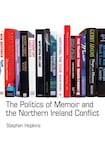
I often get asked to suggest a book one might read for a good overall introduction to the Troubles in Northern Ireland. There have been a few primers that were too elementary or that veered to one perspective. Given that the history of the place is often told as myth or propaganda, a writer who can avoid the influence of both is rare.
Stephen Hopkins has not set out to write a history or political analysis. His objective is simple: to discuss whether the many memoirs written by people close to the Troubles are of use to historians or others researching the period. He concludes that they are, although they have to be interrogated for their political positioning and for the danger of inaccuracy, memory itself being a “creative writer”.
What makes the book perhaps unintentionally valuable is that it is a trawl through a vast body of writing by others. It looks at memoirs by Provisional republicans, SDLP supporters, government ministers, loyalists, journalists and victims. And in summarising and assessing this work Hopkins inevitably presents the perspectives of the most eloquent on all fronts. What more could a student of the story want to start off with? The answer to that depends on whether memoir is valuable as part of the historical record.
“Irish memoirists,” Hopkins writes, “have been as concerned with representing the group as with representing the self.” He sees that tendency in older memoirs, too, and in much communist writing. Some memoirists had little interest in telling their stories unless they could present their experience as typical of people in their community or party.
Intriguing reflection
One intriguing reflection based on the reading of books by former IRA members is about how personal the fight was for them. The memoirist, he writes, may demonstrate a sense of self that is more concerned with the political collective than with the private space. Another recent book,
Children of the Revolution
(edited by Bill Rolston), hears the children of paramilitaries recount the experience of having a parent who put the struggle before family. Hopkins writes of these memoirs “belying the commonly held belief that intimacy and ideology are lived out in separate spheres”.
In looking at the Provisionals a division emerges immediately between those who accept the approved party narrative, best embodied in the writings of Gerry Adams, by which the IRA fought a legitimate war towards a good result, and others who started out alongside Adams, perhaps inspired by him, but have concluded that he betrayed their cause. What strikes Hopkins is that it is the intellectual dissidents within republicanism who are the better writers. He unpicks some of the anomalies in the writings of Adams, effectively accusing him of “political lying”, taking an approach that serves the party interest but is not “justifiable to a wider readership.” He quotes the argument of Fintan O’Toole (this newspaper’s literary editor) that the lie that Adams was not in the IRA may have as much to do with protecting the IRA from having to answer for itself as it has with protecting the man himself.
An example of work that contests the orthodoxy is Richard O'Rawe's books Blanketmen and Afterlives, written, effectively, to accuse the Adams leadership of prolonging the hunger strike against the wishes of the prisoners' leaders. Eamon Collins's Killing Rage is, he judges, the most powerful example of dissident writing to have emerged so far.
Adjusting the record
The observation that many of these memoirists were able to turn to the subject only many years after events that trouble them raises questions about whether they are retrospectively justifying themselves, adjusting the record to suit their perspective, as seems to be the case with Collins, or unburdening themselves of grievances they have carried too long, as with O’Rawe.
Hopkins explores the question of why writing of this quality by O’Rawe and Collins has not emerged from loyalism. The memoirs of Johnny Adair and Michael Stone were ghostwritten by journalists. More interesting works have been produced by biographers of loyalists, such as Roy Garland (of Gusty Spence) and Henry Sinnerton (of David Ervine). Some memoirs, like Stone’s, are self-justifying and self-glorifying, even cloyingly narcissistic. Some are self-reflective.
This is a short book with an enormous range. A chapter dealing with journalists covers one of my own books, The Telling Year, alongside Henry McDonald's Colours, to explore the question of whether journalists are better judged in their work against an understanding of their background. Other journalists in Northern Ireland have thought it important to disclose little of their community background because they feared that doing so would compromise the integrity of their journalism. And there are other journalist memoirists Hopkins has missed, such as Tim Brannigan and Walter Ellis. The same chapter analyses books by Kevin Myers and Mark Davenport, who, by contrast, came in from outside. Both expressed dissatisfaction with journalism's frequency and brevity as a medium for explaining the society they had been assimilated into. They became local. Davenport wanted to join the grieving for the dead of Omagh, not just to write about it.
Hopkins’s question is a simple one – whether memoir is valuable resource material – and he concludes that it is, having unpacked the caveats. But in his journey through this material he has provided a short yet comprehensive account of Troubles-related memoir that can benefit anyone who wants to read about Northern Ireland’s recent history. Written as an academic work, and priced as one, it belongs rightly with the general reader. At an absurd £75, you’re best looking for this at your library.











